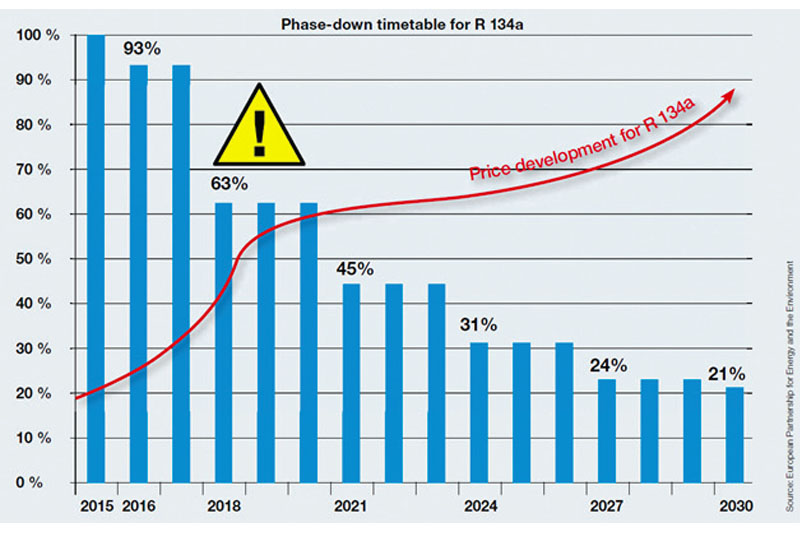
R134a refrigerant is going up in price, leading unscrupulous criminals to supply counterfeit refrigerant, supplied in illegal containers, to take advantage of unsuspecting workshops across Europe. So, don’t get duped into purchasing it, warns Denso.
The reason that prices are rising is linked to changes in European legislation that began in 2014, when the European Commission decided to control emissions from fluorinated greenhouse gases (F-gases), including hydrofluorocarbons (HFCs), and the EU adopted two legislative acts: the F-gas Regulation and the Mobile Air Conditioning (MAC) Directive. The aim of both acts is to enforce the use of gases with a global warming potential (GWP) lower than 150.
In addition, in 2015, the EU introduced the phase down mechanism to gradually reduce the consumption of high GWP refrigerants, like R134a, which until recently was the most common air conditioning refrigerant used by the world’s vehicle manufacturers (VM), so that in 2030, only one fifth of the 2014 total sales volume of high GWP HFC’s, should be available on the market.

R134a is an HFC that has a GWP of 1430, whereas CO2 has a GWP of one. Releasing one KG of R134a refrigerant into the atmosphere, is an equivalent of 1430 KG of CO2. Once released into the atmosphere, it will take, on average, 12 years before R134a is removed through natural processes, such as atmospheric reactions and uptake by vegetation.
However, it should be noted that the concentration of R134a in the atmosphere will continue to increase for as long as it is still being used and released into the atmosphere. For example, it is (accidently) blown off into the atmosphere, instead of being recovered by using an A/C refilling machine. By comparison, R1234yf, which has now replaced R134a as the favoured VM refrigerant, will remain in the atmosphere for just 11 days!
As demonstrated by the phase down timetable, only 45 per cent of the total volume of R134a sold in 2014 was available in the market in 2023, and this will reduce to just 31 per cent during this year. This has meant the price for R134a has increased dramatically, especially in 2018, when the availability dropped from 93 per cent to 63 per cent, so the market panicked and the price skyrocketed. As a result, grey import, or the smuggling of counterfeit and illegal refrigerants, increased significantly, particularly from countries outside the EU.
Defining counterfeits
Counterfeit refrigerants are defined as impure, imitation refrigerants that usually consist of blends of already forbidden refrigerants like R12 or R22, are hazardous, and usually sold in disposable cylinders at discounted prices. Trade in counterfeit refrigerants is on the rise and that brings a variety of consequences, including poor performance, costly damage to machines and equipment, but most importantly, serious safety hazards that could result in explosions and the possible loss of human life.

Disposable cylinders
Counterfeit refrigerants are usually offered in disposable cylinders, due to their relatively low price and lack of traceability. However, the use of disposable cylinders has been forbidden in the EU since 2007, but in spite of this, ‘do tt yourself’ cans are becoming more common in Europe.
How can you avoid counterfeit or illegal refrigerants? You should source refrigerants from reliable and reputable sources that are verified suppliers and manufacturers and only buy refrigerants supplied in environmentally friendly, re-usable cylinders, with traceability. You should verify the source and authenticity of the refrigerant. Despite the financial pressures in the independent workshop, buying cheap counterfeit refrigerant is simply not worth the risk. Not only is it illegal and hazardous, but it will also void a warranty claim should any traces of counterfeit refrigerants be found in any Denso component. So, in short, it must be avoided at all costs!









